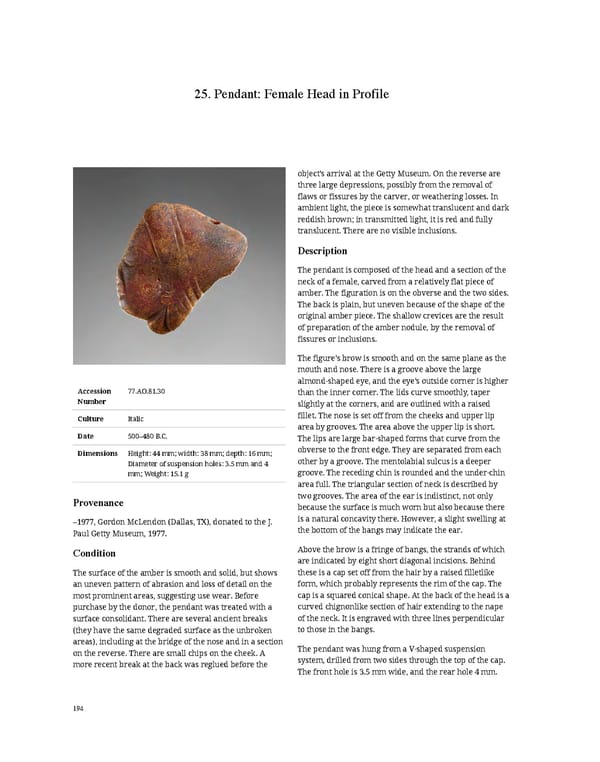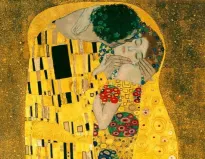25. Pendant: Female Head in Profile object’s arrival at the Getty Museum. On the reverse are three large depressions, possibly from the removal of flaws or fissures by the carver, or weathering losses. In ambient light, the piece is somewhat translucent and dark reddish brown; in transmitted light, it is red and fully translucent. There are no visible inclusions. Description The pendant is composed of the head and a section of the neck of a female, carved from a relatively flat piece of amber. The figuration is on the obverse and the two sides. The back is plain, but uneven because of the shape of the original amber piece. The shallow crevices are the result of preparation of the amber nodule, by the removal of fissures or inclusions. The figure’s brow is smooth and on the same plane as the mouth and nose. There is a groove above the large almond-shaped eye, and the eye’s outside corner is higher Accession 77.AO.81.30 than the inner corner. The lids curve smoothly, taper Number slightly at the corners, and are outlined with a raised Culture Italic fillet. The nose is set off from the cheeks and upper lip area by grooves. The area above the upper lip is short. Date 500–480 B.C. The lips are large bar-shaped forms that curve from the Dimensions Height: 44 mm; width: 38 mm; depth: 16 mm; obverse to the front edge. They are separated from each Diameter of suspension holes: 3.5 mm and 4 other by a groove. The mentolabial sulcus is a deeper mm; Weight: 15.1 g groove. The receding chin is rounded and the under-chin area full. The triangular section of neck is described by Provenance two grooves. The area of the ear is indistinct, not only because the surface is much worn but also because there –1977, Gordon McLendon (Dallas, TX), donated to the J. is a natural concavity there. However, a slight swelling at Paul Getty Museum, 1977. the bottom of the bangs may indicate the ear. Condition Above the brow is a fringe of bangs, the strands of which are indicated by eight short diagonal incisions. Behind The surface of the amber is smooth and solid, but shows these is a cap set off from the hair by a raised filletlike an uneven pattern of abrasion and loss of detail on the form, which probably represents the rim of the cap. The most prominent areas, suggesting use wear. Before cap is a squared conical shape. At the back of the head is a purchase by the donor, the pendant was treated with a curved chignonlike section of hair extending to the nape surface consolidant. There are several ancient breaks of the neck. It is engraved with three lines perpendicular (they have the same degraded surface as the unbroken to those in the bangs. areas), including at the bridge of the nose and in a section The pendant was hung from a V-shaped suspension on the reverse. There are small chips on the cheek. A system, drilled from two sides through the top of the cap. more recent break at the back was reglued before the The front hole is 3.5 mm wide, and the rear hole 4 mm. 194
 Ancient Carved Ambers in the J. Paul Getty Museum Page 203 Page 205
Ancient Carved Ambers in the J. Paul Getty Museum Page 203 Page 205
